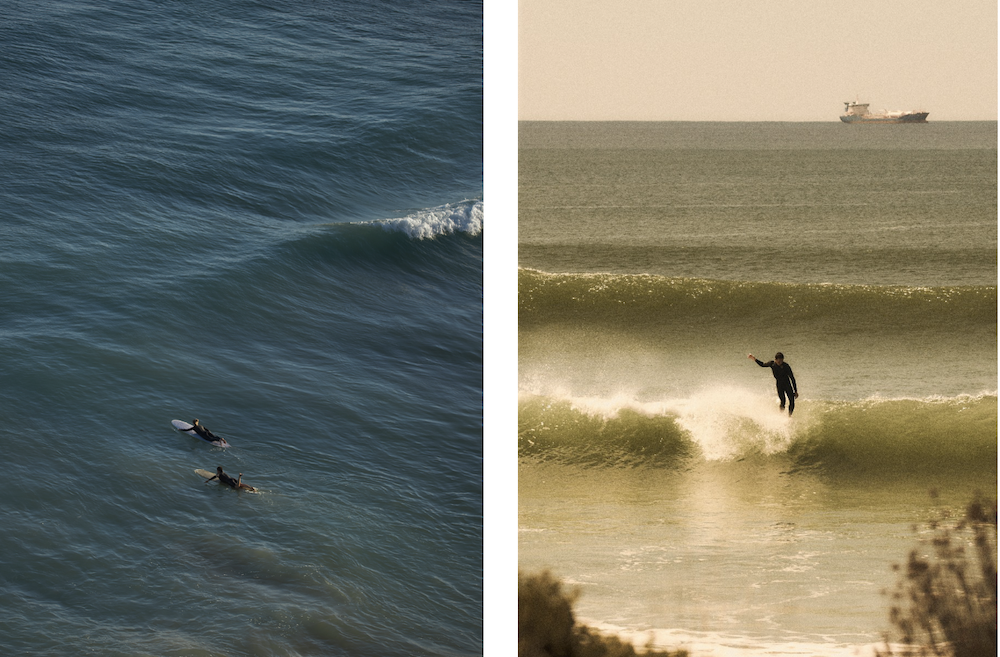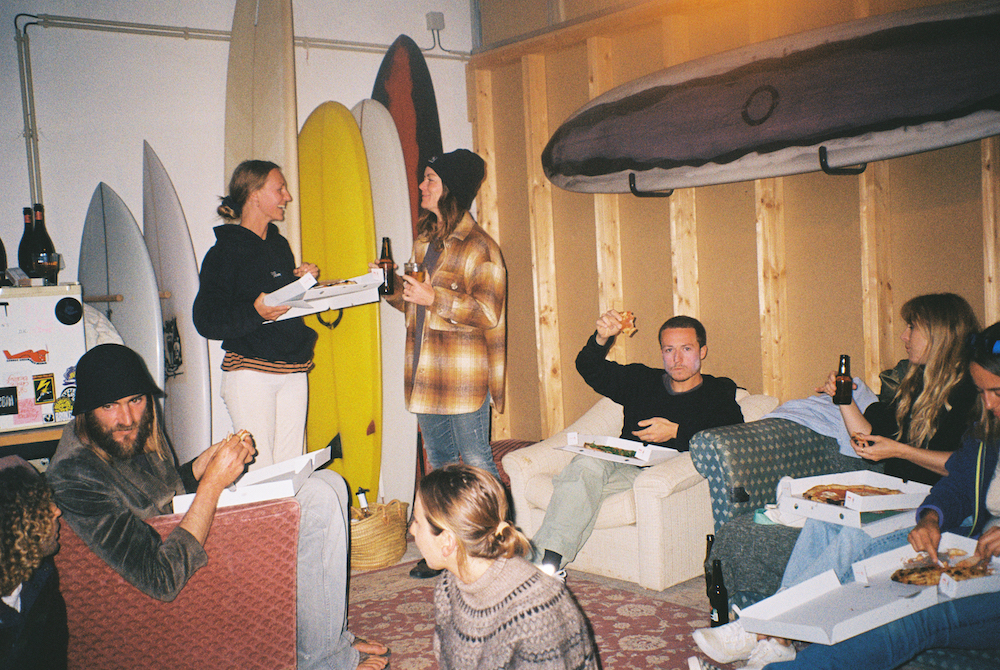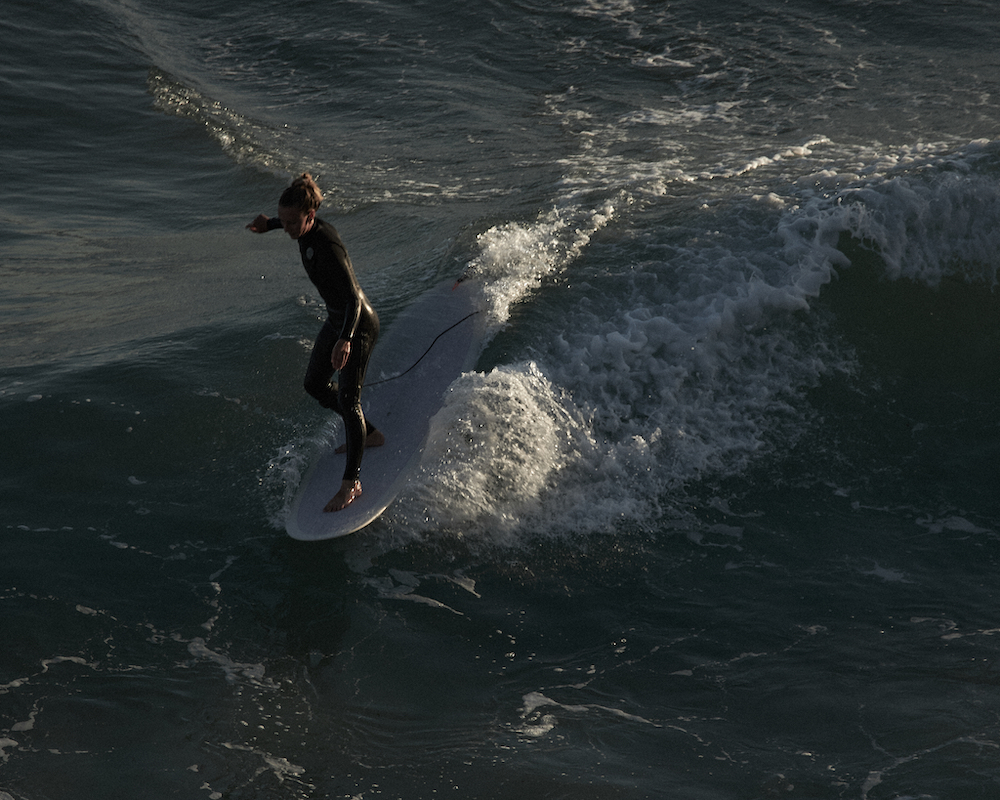Southern Portugal has been proving a mecca for creative talent in recent years, a funky kinda free-wildness permeating the farthest Atlantic tip of Europe, arguably shedding its golf/boozehound abroad coat of yesteryear, with a rad raft of exciting and progressive burgeoning businesses. From movers and groovers to shapers and makers that include classic logs and retro shapes from Bobs Board and JNR Custom Surfboard, and big-wave local, Alex Botelho’s go-to shaper Ferox’s boards made from local cork trees. Southern Portugal’s melting pot of creativity, culture, and an off-kilter approach to craftsmanship is proving a recipe for far-out novel approaches to shaping and design.
Proving to play a vital part in this thriving creative community are star-crossed lovers, surfers, business partners and shapers, Matthew Ryall and Rhosanna Lowe. The French/English/Welsh couple are crafting far-out surfboards based from a new creative commune, the Happy Chemicals Factory, in the boonies of Southern Portugal’s beautiful countryside.
We caught up with the couple to find out more about their new creative partnership, Toxic Magic, as well as their visions for the future.

WL: Hey guys, how’s it going? Tell me about the formation of Toxic Magic…
M: It’s still up for debate who came up with the wordplay “toxic/magic” but Toxic Magic as a brand was formed in 2020. We both worked at a hostel called Bura Surfhouse, and they kindly allowed me to take over their pool shed when I wanted to start making surfboards. To say that it was a makeshift operation is an understatement, but it’s where the first 5 surfboards were made.
WL: Matt, where did you start shaping and which shapers would you say are your greatest influences?
M: I first shaped a board with a good friend of mine called Olivier, who makes hollow wooden surfboards under the brand Cachalot Surfboard. I later shaped a couple of boards with Sam of Bob’s Boards, and did some ding repairs for him. But in all honesty I jumped in at the deep end very early on and had to figure a lot out by myself. Since moving into our factory and working alongside other shapers, I’ve found that bouncing ideas off each other has been the greatest source of improvement. We are able to try each other’s boards out and learn from our mistakes. The advantage we have compared to solo shapers is incalculable. We recently had the amazing opportunity to laminate for Robin from Gato Heroi this summer and definitely came out of that feeling pretty inspired and having gained a lot of experience.
The people who really inspire me tend to be pretty unrelated to surfing. Devon Turnbull, fashion designer turned hi-fidelity speaker maker, merged the niche hi-fi world with some of the most exclusive streetwear brands. Joe Lauder, founder of Satta, started making 70s style cruiser skateboards out of a carpentry workshop and turned it into a fashion brand. Goldie, an influential graffiti artist became a legendary jungle DJ in the 90s and whilst he gained super-fame from appearing in James bond, his music is where it’s at. These three guys were able to establish themselves and then switch mediums whilst retaining relevancy and integrity as artists or designers.

WL: What’s the overall vision for Toxic Magic?
R: From the beginning, we knew that we wanted to make surfboards that work, look good, and are affordable for more than just the wealthy tourists passing through. So although we want to grow, we also want to remember that initial goal. We also want to do so much more than make surfboards, we both love to create and so we hope to use Toxic Magic as a way to enable us to do that.
WL: Matt, what styles of surfing do your boards most suit?
M: It’s important for me not to dilute the brand by catering to the mainstream and short lived trends. That being said, with the variety of boards that we make, most people can find something that will work for them. We like timeless and stylish surfing and our main challenge is to make boards that promote that in other people.
WL: You’ve got some awesome designs amongst your surfboard fleet. What took you down this route?
M: Our board designs are heavily derived from my own interests and pursuits. I enjoy riding a wide variety of boards and am pursuing multiple avenues of research into board design. I’ve been enjoying working on twinzer short boards as a progression from the twin you ride as your daily. One of my personal favourites is a step-up quad with a modern approach, for surfing rail to rail on the big point breaks around here. My go-to is still a classic log and I’ve been working on a few different models that work well on the local breaks.

WL: Rhosanna, there aren’t many women in the shaping industry. How and when did you start glassing?
R: During the first year of Matthew working full time on the brand, I was working as a freelance designer and was pretty focussed on being as successful as possible. I studied illustration at university and have always wanted to make a living creatively. At the same time, I started helping out with fibreglass panels for fins and on some of the laminations. I realised quickly that this was what I wanted to be doing full time. Matthew taught me everything he knew and I gradually phased out all of my freelance work so that I could focus on glassing. It really hadn’t occurred to me that glassing full time was something I could do or might want to do, and it certainly hadn’t yet occurred to me that I’d be one of few women doing this. But being an artist is the dream and being great at something is my goal, so I’ve been investing all of my energy into this, and loving it.
All the guys I work with in the factory are amazing. We have a lot of fun and I feel incredibly respected by them at all times. The reality is that I now have the most experience when it comes to glassing and so I often help out with their laminations, but that’s not to say that I don’t learn from them. Thankfully, we are all open to helping each other and sharing new techniques, it’s an incredible environment for learning and growth.
The main issue I have is that people tend to address Matthew when discussing business with us. Whether it’s via message or in person, people don’t seem to realise that we are a team, or if they do, they assume that Matthew is the one they should be talking to. This doesn’t surprise me too much, he’s a good surfer and is the one shaping the boards, but there is a lot more that goes into the production of surfboards and the running of a business than just surfing and shaping . This is a microcosm of what is happening in the industry at large. Shapers are at the forefront, whilst glassing doesn’t seem to be viewed as highly. So, we have been working pretty hard to make sure our instagram portrays us accurately so that people know from the offset that we are a team.
WL: What are some of the issues you’ve faced working together as a new business?
R: We have always worked on projects together, but this is the first time that our sole form of income is coming from the work we do together. This adds a layer of pressure to what we are doing. We have had some very difficult months where we felt like it would never get easier, but this has mostly been due to the typical issues with starting a business; cash flow, unpaid invoices and material supply shortages. It has definitely been an adjustment, but we are pretty good at communicating when we have a problem. Working together is both a compromise and the sum of our ideas. Having a real understanding of each other’s character and needs, paired with open communication has been the key.

WL: What is the ‘Happy Chemical Space?’
R: ‘Happy Chemicals’ is the name of our factory where we work alongside friends/shapers. We share the space with Adam (Mada Surfboards), Tobi (Eternal Circle Surfboards) and Alex (Bad Rug). But we also have an open-door policy so that anyone with questions or in need of some help can stop by and chat. There are a lot of young amateur shapers coming up in the area and we try our best to support them. Over the past year, the factory has developed a community feeling, which is something we always wanted.
The factory started as an empty space for us to do and create whatever we wanted. We actually lived there in a tent for a few weeks when we were particularly broke and trying to figure out our next living situation. It quickly evolved into a collaborative shaping space as we continued to meet people wanting somewhere to shape. So we built more rooms and maximised the space to accommodate more people. This involved moving our glassing room upstairs, almost doubling capacity. The board building industry can be very closed and at times hostile when it comes to sharing ideas and helping each other out, so we wanted to create a space that encourages collaboration. People ask us at times how it works to have multiple brands under one roof, whether it is competitive, but so far, it’s not. We encourage clients to work with each other depending on what they are looking for. We acknowledge the differences in our brands and enjoy seeing each other succeed, and we help each other a lot. Tobi has his own brand but also sands boards for us when we have a lot of orders. He has been instrumental in allowing us to grow, by helping out with sanding whenever we need.
WL: Why is the Algarve such a great place to run your business?
R: The Algarve is brimming with untapped creative energy. Not only is this a place for holiday goers and retirees looking for golf and sunshine, it’s a major stop on the van-life winter migration route and a winter hotspot for digital nomads. If you look past all the cheesy labels, you see an influx of people for short term, seasonal and long-term stays. The short-term holidays support the tourism industry and businesses, which are manned by seasonal workers and often owned by expats. In conjunction with the winter migration of people chasing waves, you end up with a year-long thriving economy for surf related businesses (let’s not talk about surf-schools) with no real off-season. With this large movement of young people and lack a cultural infrastructure, we are starting to see the buds of something new. It does look awfully similar to gentrification though. Obviously, there are many challenges with starting a business abroad, not to mention picking one of the furthest corners of Europe, but there are advantages to being one of the first if you can survive.

WL: You’ve done some awesome collaborations, tell us a bit more about them…
R: Over the last year we’ve worked with a few shops across the Algarve to create boards. One of our greatest collaborations has been with System Surfboards, a brand that works with local shapers to make boards to be sold in local surf shops, JahShaka and Quiksilver Lagos. We also recently created some higher-end boards for a new concept store in Lisbon called Rove. This was exciting as it allowed us to add all the ‘bells and whistles’ to make premium boards; resin panels, fibreglass staining, handmade resin tail blocks, polish finish etc. We also collaborated with a local tattoo artist and all-round creative legend, Catherina Cardoso, to make artwork for some boards. She has been hugely inspiring and is honestly one of the most interesting and talented people we’ve had the pleasure of knowing and working with here.
WL: What are your aspirations for the future?
R: We’ve often discussed this subject because it is not always easy as a brand to know what you are trying to achieve. Most surfboard brands tend to scale up production as a means of growth. We like the idea of progressing horizontally. Building a flexible platform that allows us to continue exploring our artistic endeavours, whether it be surfboards, clothing, speakers, furniture or art.
All photography by Hugo Pascal and Deb Pascal @hugoanddeb
